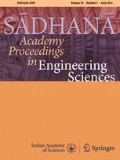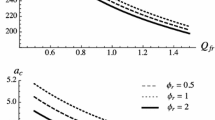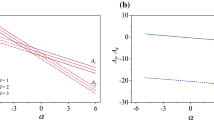Abstract
The onset of convection instability in a differentially heated layer consisting of gray and non-gray gaseous mixtures is studied numerically. The conditions investigated cover a wide range of Planck number values (\(Pl = \dfrac{\kappa k_T}{4\sigma T_0^3}\)), from the conduction-dominated regime of \(Pl\gg 1\) to the radiation-dominated regime of \(Pl \ll 1\). The linear stability theory is applied to mass, momentum and energy balance equations and the resulting linear stability equations are solved by Chebyshev spectral collocation method. The divergence of radiative flux is solved by the finite-volume-based discrete ordinates method. The Spectral Line Weighted sum of gray gas (SLW) model is used to represent the fine spectral variation of absorption coefficient for a non-gray gas medium. The results indicate that the critical Rayleigh number (\(Ra_c\)) for the onset of convection increases with mean temperature (\(T_0\)) in the conduction-dominated regime at low values of \(T_0\). In the radiation-dominated regime (\(Pl\ll 1\)), \(Ra_c\) decreases with \(T_0\) for gray media. If the medium is non-gray, the critical \(Ra_c\) reduces to even lower values (as compared with those of gray gases) due to the dependence of gas absorptivity on temperature \(T_0\). A reduction in the wall emissivity value increases the stability of the fluid layer due to reflection of radiation from the wall, in the radiation-dominated regime. The reverse trend is seen for \(Pl\gg 1\). The critical parameters also significantly depend on the concentrations of radiatively participating gases in the mixture. The temperature profile in the fluid layer transforms from a linear profile in conduction regime to a stratified profile with steep gradients near the walls, in the presence of non-gray participating gases.














Similar content being viewed by others
Abbreviations
- \(C_p\) :
-
specific heat at constant pressure, J/kg K
- d :
-
separation distance, m
- G :
-
total irradiation, W/m\(^2\)
- g :
-
acceleration due to gravity, m/s\(^2\)
- I :
-
total intensity of radiation, W/m\(^2\) sr
- \(k_T\) :
-
thermal conductivity, W/m K
- Pl :
-
Planck number, \(\dfrac{\kappa k_T}{4\sigma T_0^3}\)
- Pr :
-
Prandtl number, \(\dfrac{\nu }{\alpha }\)
- q :
-
heat flux, W/m\(^2\)
- Ra :
-
Rayleigh number, \(\dfrac{g\beta \Delta T d^3}{\nu \alpha }\)
- T :
-
temperature, K
- t :
-
time, s
- \(T_1\), \(T_2\) :
-
bottom and top wall temperature respectively, K
- \(T_0\) :
-
mean temperature, K
- \(\vec {V}\) :
-
velocity vector, \(\vec {V}= u\vec {i} + v\vec {j} + w\vec {k}\)
- W :
-
amplitude of velocity perturbation
- Y :
-
species mole fraction
- Z :
-
vertical distance, m
- \(\alpha \) :
-
thermal diffusivity, m\(^2\)/s
- \(\alpha _s\) :
-
non-dimensional static temperature gradient
- \(\nu \) :
-
kinematic viscosity, kg/m-s
- \(\rho \) :
-
density, kg/m\(^3\)
- \(\kappa \) :
-
absorption coefficient, 1/m
- \(\Omega \) :
-
solid angle, sr
- \(\epsilon \) :
-
emissivity
- \(\theta \) :
-
non-dimensional temperature field, \(\theta = \dfrac{(T-T_c)}{(T_h - T_c)}\)
- \(\phi \) :
-
amplitude of temperature perturbation
- \(\sigma \) :
-
Stefan–Boltzmann constant, \(5.67\times 10^{-8}\) W/m\(^2\) K\(^4\)
- \(\tau \) :
-
optical thickness, \(\tau = \kappa L\)
- b:
-
black body
- j :
-
non-gray gas index
- c:
-
conduction mode
- r:
-
radiation mode
- s:
-
static condition
- w:
-
wall
References
Lord Rayleigh 1916 LIX. On convection currents in a horizontal layer of fluid, when the higher temperature is on the under side. The London, Edinburgh, and Dublin Philosophical Magazine and Journal of Science 32(192): 529–546
Anne Pellew and Richard Vynne Southwell 1940 On maintained convective motion in a fluid heated from below. Proceedings of the Royal Society of London A 176(966): 312–343
Sparrow E M, Goldstein R J and Jonsson V K 1964 Thermal instability in a horizontal fluid layer: effect of boundary conditions and non-linear temperature profile. Journal of Fluid Mechanics 18(4): 513–528
John Gille and Richard Goody 1964 Convection in a radiating gas. Journal of Fluid Mechanics 20(1): 47–79
Spiegel E A 1960 The convective instability of a radiating fluid layer. The Astrophysical Journal 132: 716
Christophorides C and Davis S H 1970 Thermal instability with radiative transfer. Physics of Fluids 13(2): 222–226
Arpaci V S and Doğan Gózúm 1973 Thermal stability of radiating fluids: the Bénard problem. Physics of Fluids 16(5): 581–588
Lienhard J H 1990 Thermal radiation in Rayleigh–Bénard instability. Journal of Heat Transfer 112(1): 100–109
Bdéoui F and Soufiani A 1997 The onset of Rayleigh–Bénard instability in molecular radiating gases. Physics of Fluids 9(12): 3858–3872
Hutchison J E and Richards R F 1999 Effect of nongray gas radiation on thermal stability in carbon dioxide. Journal of Thermophysics and Heat Transfer 13(1): 25–32
Mukutmoni D and Yang K T 1995 Thermal convection in small enclosures: an atypical bifurcation sequence. International Journal of Heat and Mass Transfer 38(1): 113–126
Lan C H, Ezekoye O A, Howell J R and Ball K S 2003 Stability analysis for three-dimensional Rayleigh–Bénard convection with radiatively participating medium using spectral methods. International Journal of Heat and Mass Transfer 46(8): 1371–1383
Wen Mei Yang 1990 Thermal instability of a fluid layer induced by radiation. Numerical Heat Transfer 17(3): 365–376
Swaminathan Prasanna and Venkateshan S P 2014 Convection induced by radiative cooling of a layer of participating medium. Physics of Fluids, 26(5): 056603
Larson V E 2001 The effects of thermal radiation on dry convective instability. Dynamics of Atmospheres and Oceans 34(1): 45–71
Moufekkir F, Moussaoui M A, Mezrhab A, Naji H and Lemonnier D 2012 Numerical prediction of heat transfer by natural convection and radiation in an enclosure filled with an isotropic scattering medium. Journal of Quantitative Spectroscopy and Radiative Transfer, 113(13):1689–1704
Dandy D S 2017 Chemical and Biological Engineering, Colorado State University, Colorado http://navier.engr.colostate.edu/~dandy/code/code-2/index.html
Subrahmanyan Chandrasekhar 2013 Hydrodynamic and hydromagnetic stability. Courier Corporation
Claudio Canuto, Hussaini M Y, Alfio Quarteroni, Thomas Jr A et al 2012 Spectral methods in fluid dynamics. Springer Science & Business Media
Haidvogel D B and Thomas Zang 1979 The accurate solution of Poisson’s equation by expansion in Chebyshev polynomials. Journal of Computational Physics 30(2): 167–180
Minkowycz W J, Sparrow E M, Murthy J Y and Abraham J P 2009 Handbook of numerical heat transfer. John Wiley & Sons, Inc., Hoboken, NJ
Denison M K and Webb B W 1995 Development and application of an absorptionline blackbody distribution function for CO2. International Journal of Heat and Mass Transfer 38(10): 1813–1821
Pearson J T, Webb B W, Solovjov V P and Jiefu Ma 2014 Efficient representation of the absorption line blackbody distribution function for H2O, CO2, and CO at variable temperature, mole fraction, and total pressure. Journal of Quantitative Spectroscopy and Radiative Transfer, 138: 82–96
Hottel H C and Sarofim A F 1965 Radiative transport. McGraw Hill, New York
Hongmei Zhang and Modest M F 2002 Evaluation of the Planck-mean absorption coefficients from HITRAN and HITEMP databases. Journal of Quantitative Spectroscopy and Radiative Transfer 73(6): 649–653
Solovjov V P and Webb B W 2000 SLW modeling of radiative transfer in multicomponent gas mixtures. Journal of Quantitative Spectroscopy and Radiative Transfer, 65(4): 655–672
Author information
Authors and Affiliations
Corresponding author
Rights and permissions
About this article
Cite this article
Cholake, S., Sundararajan, T. & Venkateshan, S.P. Onset of natural convection in a differentially heated layer of gray and non-gray gas mixtures. Sādhanā 46, 25 (2021). https://doi.org/10.1007/s12046-020-01542-8
Received:
Revised:
Accepted:
Published:
DOI: https://doi.org/10.1007/s12046-020-01542-8




